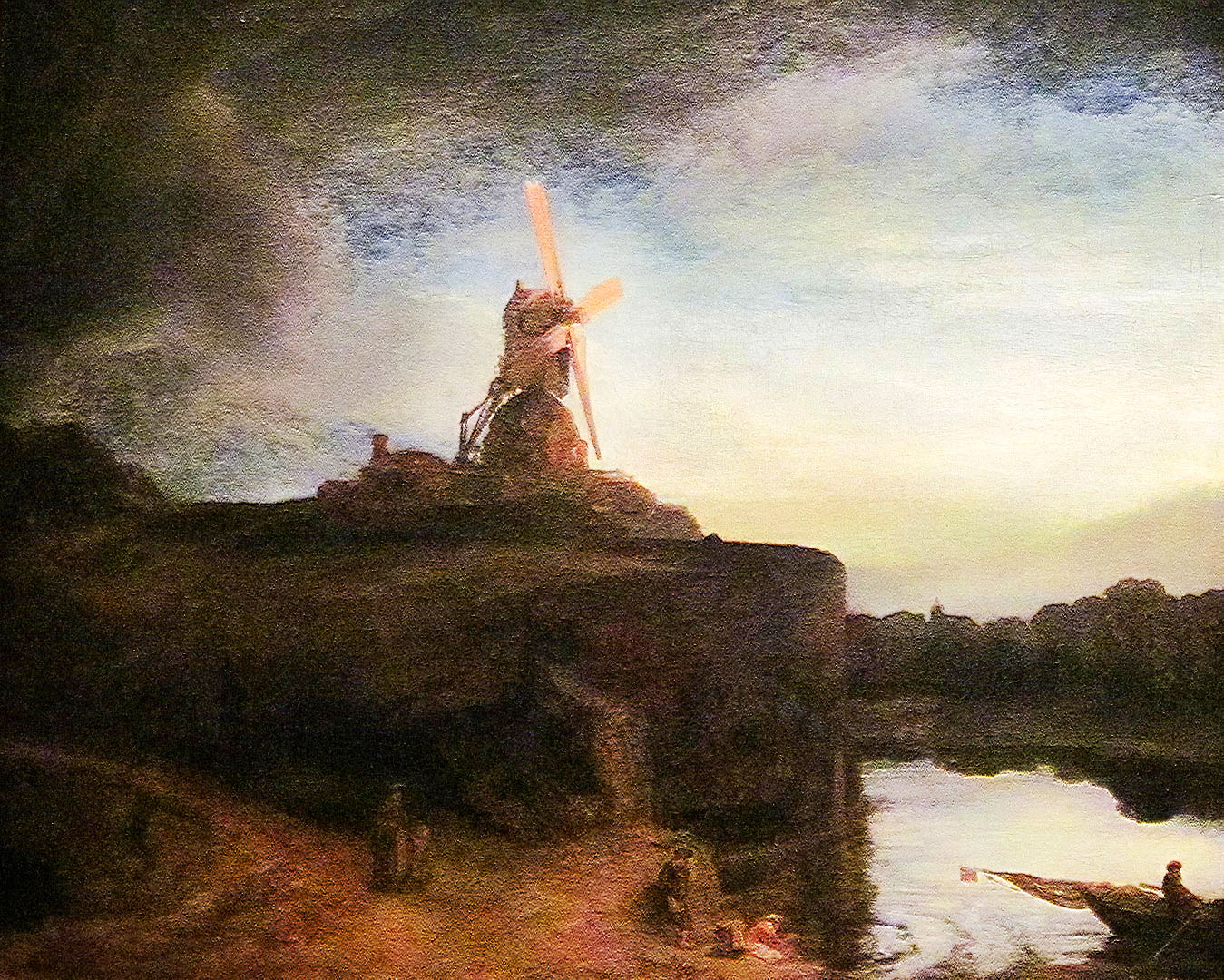
The Mill Painting by Rembrandt
A Masterpiece of Shadow, Solitude, and Symbolism
Among the lesser-known yet deeply evocative paintings by Rembrandt van Rijn, The Mill stands as a haunting meditation on solitude, nature, and the human soul’s confrontation with the eternal. Painted during a period of deep personal and artistic introspection, The Mill is often overshadowed by the more celebrated portraits and biblical scenes in Rembrandt’s oeuvre. However, for those who spend time with this enigmatic work, its emotional resonance and symbolic complexity reveal a masterpiece that transcends the landscape genre and offers a profound philosophical statement on life itself.
What Is The Mill All About?
Painted between 1645 and 1648, The Mill is widely believed to have been created during Rembrandt’s mature period, an era marked by the artist’s transition from the golden, polished style of his youth into the more introspective, shadow-filled, emotionally raw techniques that would define his late career.
At first glance, The Mill appears to be a simple landscape: a lone windmill stands atop a hill, its silhouette dominating the vast, moody sky. Below, a quiet river reflects the gathering dusk. Figures can barely be discerned in the shadows, two peasants by the water, a woman trudging up a path, and distant silhouettes fading into the scenery. But as is often the case with Rembrandt, simplicity gives way to complexity. This is not merely a painting of a Dutch countryside windmill; it is a visual poem steeped in metaphor, light, and psychological depth.
A Glimpse into the Painting
Let us take a moment to visualize The Mill.
The sky is dark and turbulent, storm clouds gather in the upper reaches of the canvas, imbuing the scene with a looming sense of drama. The windmill, centrally placed, is both a guardian and a sentinel, standing tall above the watery landscape. Its sails are motionless, suggesting either a lull or an anticipation of impending movement. Light breaks through the clouds in strategic places, casting divine beams onto parts of the land and water, while other areas sink into thick shadow. A sense of equilibrium between light and dark pervades the image, this is chiaroscuro not just in a technical sense but in a spiritual one.
The Symbolism and Interpretation of The Mill
The Windmill as the Soul’s Anchor
In the 17th century Netherlands, windmills were essential to life. They pumped water, ground grain, and represented human ingenuity against the chaos of nature. In The Mill, however, the windmill takes on a symbolic and almost spiritual role. It is not merely an agricultural tool but an axis mundi, the central pivot of the world and the soul. Its placement on a hill reinforces this idea of elevated importance. Surrounded by shadow and vast space, it stands as a metaphor for constancy amid change, or perhaps faith amidst doubt.
Many art historians interpret the mill as a stand-in for the self, the individual soul, particularly Rembrandt’s own. At this point in his life, Rembrandt was facing financial difficulties, had lost his beloved wife Saskia, and was enduring social and professional setbacks. The mill, solitary yet firm, could be seen as a mirror of his personal struggles, a figure battling existential forces but not yielding to them.
Light and Shadow: Divine Dualities
Rembrandt was a master of chiaroscuro, a technique involving the dramatic interplay of light and dark to heighten emotional impact. In The Mill, this is not just a visual effect but a philosophical one. The clouds suggest turbulence or divine judgment, yet beams of light pierce through, illuminating the landscape below. This interplay could be interpreted as the tension between human suffering and divine grace, despair and hope.
The idea that the light represents divine revelation or spiritual enlightenment is supported by the way it falls selectively, almost as if guided by an unseen hand, onto the figures and paths below. It invites the viewer to consider the relationship between fate and free will, between the material world and the spiritual realm.
Figures as Emblems of Human Life
The tiny human figures in the painting are easy to overlook, but they are crucial to its interpretation. They are dwarfed by the vastness of nature and the towering mill. A woman climbs a path, perhaps symbolizing life’s arduous journey. A pair by the water might be drawing sustenance, perhaps cleansing or washing, a potential allusion to baptism or spiritual renewal.
The near-anonymity of these figures is significant. Unlike Rembrandt’s portraits, where individuality is key, here the humans are types rather than personalities, everyman and everywoman. Their scale, in relation to the natural elements, underscores humanity’s fragility and smallness in the grand scheme of existence.
What Is Happening in The Mill?
Narratively, The Mill is sparse. There is no clear story, no dramatic event unfolding. Instead, it captures a moment suspended in time, a liminal, twilight hour filled with quiet tension. The windmill is still. The sky is in flux. The humans move slowly, deliberately. This absence of conventional “action” may be part of what makes the painting so compelling. It speaks not through incident but through mood, tone, and suggestion.
One interpretation sees the scene as an allegory for life on the edge, between day and night, labor and rest, known and unknown. The mill, in its dormancy, might represent waiting or introspection. The figures below, engaged in their mundane routines, continue onward despite the encroaching gloom, as if to say: life must proceed, regardless of the cosmic backdrop.
There is also an existential reading of the painting, in which the windmill is not only the self but also time itself, a machine that grinds and turns slowly, indifferent to the lives it shadows.
What Type of Art Is The Mill?
Formally, The Mill is a landscape painting, but it resists easy categorization. It is not a topographical study, as many Dutch landscapes were, nor is it an idealized Arcadian scene in the style of Claude Lorrain. Instead, it blends realism with psychological and spiritual depth, pointing toward the romantic and expressive qualities that would come to characterize much later European art, especially in the 18th and 19th centuries.
The painting uses the conventions of Baroque art, dramatic contrasts, bold composition, emotional resonance, but applies them to a meditative, almost metaphysical subject. The lack of clear narrative, combined with its deeply moody atmosphere, even anticipates certain aspects of symbolism and romanticism, making it feel ahead of its time.
Moreover, The Mill is a rare instance in Rembrandt’s oeuvre of landscape taking center stage. He did paint several other landscapes, but they often feel like studies or sketches. The Mill, by contrast, is fully realized and emotionally loaded. It elevates the landscape from a backdrop to a protagonist.
Where Is The Mill Painting Located Today?
Today, The Mill resides in the National Gallery of Art in Washington, D.C., part of the Mellon Collection. It was acquired in 1911 by Peter Arrell Brown Widener, a Philadelphia industrialist and collector, and was later gifted to the National Gallery.
Its attribution to Rembrandt has, at times, been the subject of debate. Some art historians in the 20th century questioned whether it was entirely by the master’s hand, citing stylistic differences and compositional elements that deviate from Rembrandt’s typical work. However, current consensus, bolstered by advances in art historical scholarship and technical analysis, supports Rembrandt’s authorship, especially given the painting’s unmistakable use of light, mood, and emotional depth.
Visitors to the National Gallery who take time with the painting often describe a visceral response, a sense of awe, melancholy, and introspection. Its placement in the gallery allows it to command attention, much like the windmill commands the landscape in the painting itself.
While not as widely reproduced as The Night Watch or The Return of the Prodigal Son, The Mill has had a quiet but powerful influence. Its atmospheric quality inspired later artists, particularly in the 19th-century Romantic movement. Painters like J.M.W. Turner and Caspar David Friedrich echoed its emphasis on the sublime, the overwhelming power of nature and the solitude of the individual.
Philosophers and theologians have also found resonance in the painting. Its themes of isolation, perseverance, and the search for light in darkness align with existential and spiritual inquiries that remain timeless.
In modern times, The Mill stands as an evident to Rembrandt’s versatility and depth. It proves that he was not only a master of the human face but also of the human condition, expressed not just in portraiture, but in sky, land, and light.
The Mill by Rembrandt is more than a landscape, it is a meditation on solitude, resilience, and the eternal dance between light and darkness. Through a simple composition of a windmill and its surroundings, Rembrandt communicates truths that are universal and timeless. In doing so, he transforms a pastoral scene into a philosophical statement, and a piece of canvas into a mirror for the soul.
For those willing to look beyond its surface, The Mill offers not just aesthetic pleasure but spiritual insight. It is a painting that does not shout but whispers, inviting us to stand still, take a breath, and listen to the quiet music of shadow and light.




